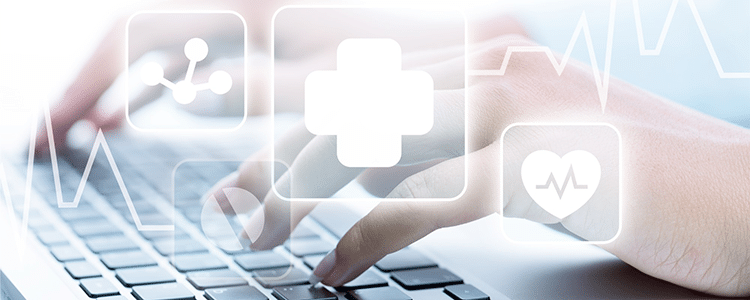According to recent research, the US healthcare ERP market size is expected to reach $2.1 billion by 2025. As the industry grows, providers are realizing the benefits of ERP in healthcare, moving data away from their disparate legacy systems and onto a single, comprehensive platform.
In doing so, they help consolidate and better organize their confidential data. They also ensure more efficient and reliable processes across their entire network.
Not sure if it’s the right move for your company? Read on. Today, we’re sharing a few of the top ways that ERP software is transforming the healthcare industry for the better.
8 Benefits of ERP in Healthcare
1. Easier Access to Medical Records
When a patient calls to make an appointment or express a medical concern, nurses and medical staff must be able to pull up that person’s record immediately. However, outdated systems make this step easier said than done.
Many providers are transferring all their paper-based and manual systems onto ERP software, and with a single click, they can access the data they need, greatly improving the patient experience.
This has especially proven true during the COVID-19 pandemic. The medical offices that have already transferred to an updated system have had an advantage over those that have not.
One of the major concerns with pandemics is overburdening the healthcare system. This problem could be mitigated if telehealth technologies were widely adopted by patients and providers. These technologies automate the monitoring of indicators such as body temperature or oxygen levels.
Coupled with the other types of data, such as medical and travel history of patients, this automation could prioritize patients who need immediate medical care. Moreover, healthcare providers could connect with many more concerned patients through telehealth technologies and alleviate unnecessary trips to emergency rooms.
ERP Selection Guide
This ERP Selection Guide will help you select technology that will support your organization for at least the next ten years.
2. Patient Confidentiality
It’s no secret that medical records are highly sensitive and confidential. Is your organization still placing them in file folders or storing them on your internal network?
If so, you could be steps away from a devastating data breach that could overthrow your reputation and financial stability. In the first half of 2019 alone, there were 32 million patient records breached!
When you move patient records onto an ERP system, you can set advanced user controls that ensure only authorized personnel have access to them.
3. Smarter Business Intelligence
Your ability to make mission-critical, lightning-quick decisions for your healthcare organization depends on your access to in-depth ERP business intelligence and operational insights.
With ERP software, you can run reports that reveal your facility’s operational performance, response rate, requisitions and more. You can also access information on your budget to help direct your spending and set future forecasts.
4. More Accurate Cost Monitoring
Healthcare organizations must manage their financial process just as every industry does. An ERP system brings various functions – from accounts and finance to human resources – under one database. This helps optimize various backend financial functions, including payroll and inventory management.
Not only can an ERP system help keep track of patient payments, but it can also help providers monitor their own expenditures. This is an ideal way to organize and reference operating costs incurred for suppliers and relevant services.
One of the best parts? As ERP is automated, it helps reduce the likelihood of human errors in both administrative operations as well as inventory-related data input.

5. Simplified Industry Compliance
In the healthcare field, regulatory compliance is a must. To respond proactively to compliance requirements, companies must ensure their operations are as visible, secure and traceable as possible. Holding tightly to outdated recordkeeping measures could mean failing an important audit or being found incompliant with an industry-specific mandate.
ERP enables you to provide necessary documentation at any given time, from anywhere. This makes adhering to industry regulations second nature, rather than a manual step you must remember.
A software consultant, like Panorama, can help you define your business requirements and ensure that ERP vendors understand your compliance needs when responding to an RFI or demoing their solution.
6. Reduced Operational Costs
Keeping operational costs low and profitability high is key to any successful organization, including those in the healthcare sector. As is the case with manufacturing and distribution industries, hospitals and medical offices need to improve operational efficiencies while also reducing inventory and labor costs.
When you consolidate a variety of operational requirements (billing, inventory, finance, supplies, etc.) into one ERP database, you can keep overhead costs at a minimum and productivity high.
7. Streamlined Process Integration
At any given time, there are hundreds of individual processes taking place within a typical healthcare setting. When each of these operates in a silo, it can result in confusion and inefficiency. In such a high-stakes industry, it could also cause more serious consequences.
This is where an ERP platform can make a world of difference. This software consolidates and connects individual processes, allowing them to flow into one another and operate seamlessly. Every team member has the data they need at their fingertips, improving team communication and collaboration.
Simply implementing an ERP system will not result in process improvement. Many organizations must focus on process reengineering in order to standardize certain processes to fit pre-configured best practices and to differentiate other processes to build competitive advantage.
To learn more about process improvement, check out our blog post, How do ERP Systems Streamline Business Processes?

8. Improved Patient Safety
Healthcare ERP makes all communication between patients and providers completely transparent. This helps trace the source of any conflict directly back to its root causes so there are no secrets or surprises.
When a patient trusts a medical professional with his or her care, it’s important that a clean and clear data stream is initiated and maintained throughout the entire interaction. Not only does this help providers protect themselves if an issue occurs, but it also keeps patients as safe as possible.
In addition, providers can also use their ERP system as a database to store their established safety protocols, so all team members can access and review them at any given time.
Reap the Benefits of ERP in Healthcare
While it’s been a go-to resource in the manufacturing sphere for years, ERP has made a major shift within the healthcare industry recently. As one of the most data-sensitive niches, providers in this industry need a software solution capable of keeping up with their evolving requirements.
In this case, the benefits of ERP in healthcare become glaringly obvious. These solutions contain specialized modules and functions designed to help providers organize their workflow, improve their patient experience, boost performance and cut costs.
The best way to achieve these benefits is to define your business requirements, follow ERP implementation best practices and seek guidance from an organizational change management consultant.
If you’re evaluating healthcare ERP solutions, request a free consultation below to learn how to find a system that meets your requirements and implement it in a way that ensures employee buy-in.













